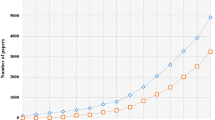Abstract
The article evaluates the body of literature on Leonardo da Vinci using for the first time bibliometric and altmetric methods for data processing. The question of whether the literature on Leonardo da Vinci reflects his interdisciplinarity as scientist and artist is addressed. We argue that the medical and material sciences show a high number of citations to the respective publications, and much higher number of citations to publications ratio than the humanities and social sciences fields. We also found that there is no relationship between the number of publications for each research area and the citations (between productivity and quality). The largest category of papers, in terms of citations and in terms of the number of subfields, discussing da Vinci’s contribution to the various sciences, belongs to exact sciences. This finding is surprising as Leonardo da Vinci has become a synonym for the mysterious artist whose paintings consist of many messages that are difficult to explain. Therefore it seems natural that Leonardo the artist would get a lot of research attention. Nevertheless, the bibliometric findings show that the academic community has interest in his contributions to science, no less than in his work of art.





Similar content being viewed by others
Further Reading
Clarivate Analytics. 2018. World of Science Citation Index. mjl.clarivate.com. Accessed January, 15 2018.
Clark, K. 1989. Leonardo da Vinci. London: Penguin Books.
Fenstad, J. E. 2013. The miraculous left hand–On Leonardo da Vinci and the search for a common understanding of man and nature. European Review, 21(1), 10–20.
Fuller, S., & Collier, J. H. 2004. Philosophy, rhetoric, and the end of knowledge: A new beginning for science and technology studies. Mahwah, NJ: Lawrence Erlbaum Associates.
Gao, J., Luedtke, W. D., Gourdon, D., Ruths, M., Israelachvili, J. N., & Landman, U. 2004. Frictional forces and Amontons' Law: From the molecular to the macroscopic scale. Physical Chemistry B, 108(11), 3410–3425.
Hamet, P., Tremblay, J. 2017. Artificial intelligence in medicine. Metabolism-Clinical and Experimental, 69, S36–S40.
Kemp, M. 2004. Leonardo. New York: Oxford University Press.
Malia, R. F., Garcia, A. T., & Silveira, J. 2018. What is the evidence that art-science-technology collaboration is a good thing? (editorial) Leonardo, 51(1), 2–2.
Meadows, A. J. 1998. Communicating science. San Diego: Academic Press.
Nicholl, C. 2005. Flights of the mind. London: Penguin Books.
OCLC World Catalog. 2017. www.worldcat.org. Accessed January 15, 2018.
Pitenis, A. A., Dowson, D., & Sawyer, W. G. 2014. Leonardo da Vinci's friction experiments: An old story acknowledged and repeated. Tribology Letters, 56(3), 509–515.
Shlain, L. 2014. Leonardo`s brain. Guilford, CT: Lyons Press.
Vaughan, L., Tang, J., & Yang, R. 2017. Investigating disciplinary differences in the relationships between citations and downloads. Scientometrics, 111(3), 1533–1545.
World Cat. 2016. https://www.oclc.org/en/worldcat.html.
Author information
Authors and Affiliations
Corresponding author
Rights and permissions
About this article
Cite this article
Tal, D., Gordon, A. Intellectual Leadership of Leonardo da Vinci: A Bibliometric Study. Soc 55, 549–554 (2018). https://doi.org/10.1007/s12115-018-0307-1
Published:
Issue Date:
DOI: https://doi.org/10.1007/s12115-018-0307-1




